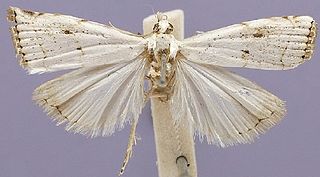
Catharylla is a genus of moths of the family Crambidae. It has Neotropical distribution from Costa Rica to southern Brazil.

Catharylla bijuga is a moth of the family Crambidae described by Théo Léger and Bernard Landry in 2014. It occurs in lowlands of the Guianas and Brazil.

Catharylla gigantea is a moth of the family Crambidae described by Théo Léger and Bernard Landry in 2014. It is found in French Guiana, Guyana and the Brazilian state of Amazonas.

Catharylla coronata is a moth of the family Crambidae described by Théo Léger and Bernard Landry in 2014. It is found in Brazil.

Catharylla mayrabonillae is a moth of the family Crambidae described by Théo Léger and Bernard Landry in 2014. It is found in Costa Rica, Panama, Colombia, Venezuela, the Guianas, Ecuador, Peru, and Brazil.

Catharylla serrabonita is a moth of the family Crambidae described by Théo Léger and Bernard Landry in 2014. It is found in the Brazilian states of Bahia and Espírito Santo.

Catharylla tenellus is a moth of the family Crambidae. It is found in the Atlantic Forest of Brazil in the states of Bahia, Minas Gerais, Paraná, Rio de Janeiro, and São Paulo.

Catharylla paulella is a moth of the family Crambidae described by William Schaus in 1922. It is found in Brazil and Bolivia.
Nymphicula mesorphna is a moth in the family Crambidae. It was described by Edward Meyrick in 1894. It is found in Myanmar, Japan and Taiwan.
Calamotropha atkinsoni is a moth in the family Crambidae. It was described by Philipp Christoph Zeller in 1863. It is found in south-east Asia, where it has been recorded from India, Sri Lanka, Thailand, Singapore and Sulawesi.
Neodactria daemonis is a moth in the family Crambidae. It was described by Bernard Landry and Alexander Barrett Klots in 2005. It is found in North America, where it has been recorded from Devil's Den State Park in Arkansas and Missouri.
Neodactria cochisensis is a moth in the family Crambidae. It was described by Bernard Landry and Valeriu Albu in 2012. It is found in North America, where it has been recorded from the Huachuca Mountains and Chiricahua Mountains in Arizona.
Scirpophaga marginepunctellus is a moth in the family Crambidae. It was described by Joseph de Joannis in 1927. It is found in Botswana, the Democratic Republic of the Congo, Madagascar, Mozambique, Nigeria, Senegal and Sudan.
Eudonia cavata is a moth in the family Crambidae. It was described by Wei-Chun Li, Hou-Hun Li and Matthias Nuss in 2012. It is found in China.
Eudonia singulannulata is a moth in the family Crambidae. It was described by Wei-Chun Li, Hou-Hun Li and Matthias Nuss in 2012. It is found in China.
Scoparia bifaria is a moth in the family Crambidae. It was described by Wei-Chun Li, Hou-Hun Li and Matthias Nuss in 2010. It is found in the Chinese provinces of Guizhou, Gansu and Hubei.

Frechinia helianthiales is a moth in the family Crambidae. It was described by Mary Murtfeldt in 1897. It is found in North America, where it has been recorded from Arizona, Illinois, Manitoba, Missouri and Oklahoma, south to Mexico.
Myriostephes haplodes is a moth in the family Crambidae. It was described by Edward Meyrick in 1887. It is found in Australia, where it has been recorded from Queensland.
Galagete consimilis is a moth in the family Autostichidae. It was described by Bernard Landry in 2002. It is found on the Galápagos Islands.
Cheverella is a monotypic genus of snout moths in the subfamily Spilomelinae of the family Crambidae. It contains only one species, Cheverella galapagensis, which is endemic to the Galápagos Islands of Ecuador. Both the genus and the species were first described by Bernard Landry in 2011. The genus is placed in the tribe Udeini.








